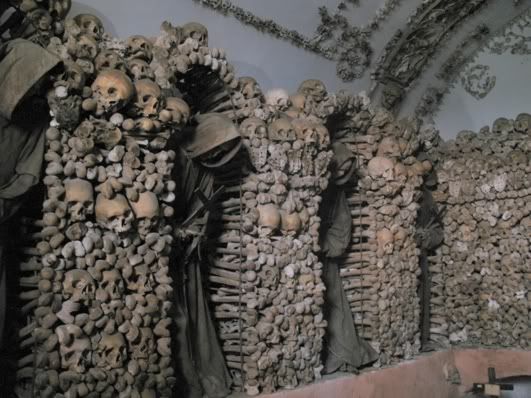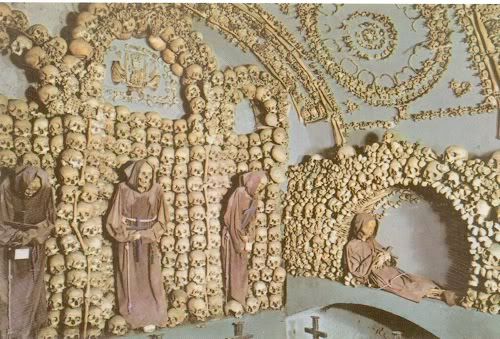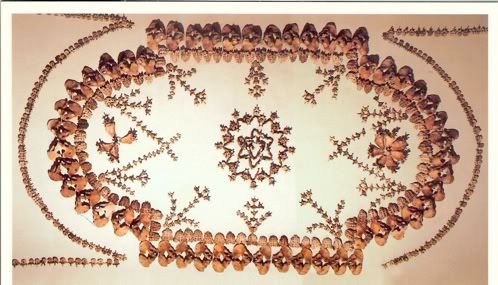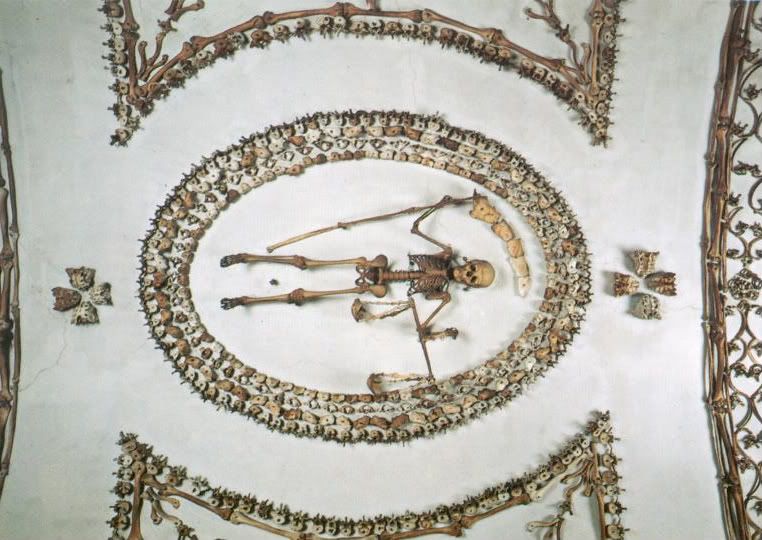Mark Dery, guest blogger for Boing Boing, has a piece up on the "philosophical investigation into the paradox of horrible beauty and the politics of 'just looking.'" In it he highlights the 17th century crypt where the Capuchin's (the religious order, not the monkey) buried their deceased brethren. I visited the crypt when I was in Rome a few years ago and, I can assure you, it's every bit as creepy as he describes.
From 1631 until 1870, the monks buried their dead here---some four thousand of them, reportedly. The musty, mineral smell of the hard-packed dirt floor mingles with the sweaty tang of your fellow Grand Tourists pressing close, their body heat turning the cramped corridor muggy.
[More photos below the fold.]
On the ceiling, skulls and what look like femurs, arranged in geometric shapes, simulate the effect of a coffered vault. Others explode in starburst patterns or tinkertoy themselves into trellises. Flanking the painting are two niches formed by arches of stacked skulls and leg- and thigh-bones; a skeleton, with just enough parchment skin still clingwrapping its skull to pass as a mummy, reposes in each, wearing the characteristic brown habit of the order.

In the second room, what might be scapulae and vertebrae describe crazy arcs across the ceiling; skeletons in habits, their empty-eyed skulls peering lugubriously out of the shadows of their cowls, stand propped against a wall of neatly stacked skulls. The third room, the Crypt of Skulls, features scapulae cascading down one wall, overlapping like scales on a suit of armor. In the fourth, the Crypt of the Pelvises, scapulae, pelvises, and assorted small bones form mescaline mandalas, turning the ceiling into a macabre kaleidoscope of fleurs-de-lis and rosettes.
By the last chamber, the brain is reeling. The claustrophobic confines of the crypt, the dizzy geometry of the anatomical arrangements, a Baroque delirium of rosettes and florettes and eight-pointed stars, all made of bones, bones, bones: it begins to feel like a bad-acid flashback, brought to you by Pol Pot. And then you come to appreciate the Spirograph rhythms of it all, the---gothic? grotesque?---aesthetic of the repeating visual melodies of capitals and crosses and cornices outlined in bones, and you remember something Francis Bacon said---"There is no excellent Beauty, that hath not some Strangeness in the Proportion"---and it makes a certain mad sense, after all.
H/T Joanna Ebenstein
- Log in to post comments




That's no monkey business there.
Sorry...couldn't resist.
I'm flattered, naturally, but wish you had flexed your intellectual muscles and offered an insightful response to my mini-essay rather than just prying loose a big hunk of it and re-posting it here. Why not bring your own considerable knowledge to bear and tell your readers something new, using my post as a springboard?
@Mark: I just greatly admired your prose and didn't think I had much more to offer at the time. However, now that you mention it, I am fascinated by this obsession that humans have over the remains of their bodies. If people are so certain that an immortal soul exists (and the Capuchins would seem to be chief among them) why the body fetish? Surely they must have just viewed it as the shell? It's also interesting to see the meticulous care that went into their designs (and in many churches in general). I wonder if there's a preponderance of OCD-type personalities in the history of the church? Specific repeating rituals, complete focus on rigid dogma, organization of objects to the minutest detail. Seems like Clomipramine might have helped.
One of the co-authors of the book "The Time Paradox," John Boyd (the other is Phil Zimbardo), writes that he saw an inscription written on the floor at the foot of a pile of bones in the crypt: 'What you are, they once were; what they are, you will be.' (punctuation added). The crypt might be seen to display a genre of art known as memento mori. It would be fascinating to learn the particular human motivations behind its construction.
Hi..great article on the Capuchin Monks..such a haunting place. I was a little creeped out by it all. I wrote about it today on lifeasahuman.com if you want to check it out..similar photos too...like minds think alike eh.
http://lifeasahuman.com/2010/travel-and-adventure/close-to-the-bone-in-…